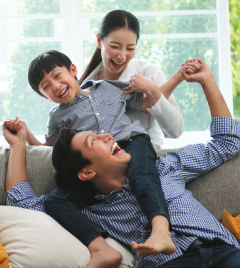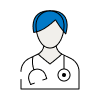Bones affected by osteoporosis are lighter and less dense than normal. They are also more likely to break, even as a result of a minor bump or fall, or even without an injury. Osteoporosis means porous bones.
Osteoporosis is around four times more common in women than men, and most common in women who have been through the menopause.
As well as bones such as the wrist or hip breaking more easily than usual, osteoporosis can result in small fractures of the bones in the spine. This can cause a curved back and a loss of height.
The inside of a bone consists of a strong mesh made of protein and minerals (particularly calcium). This mesh is living tissue that is constantly being renewed by a process called bone turnover. Old, worn out bone is broken down and absorbed by the body while, at the same time, new bone tissue is created from fresh protein and minerals. In children and young people, more new bone is created than is broken down. This makes bones both bigger and denser.
The bones are at their strongest when the peak bone mass is reached, and this usually occurs in a person's mid-twenties. Peak bone mass is then maintained for about ten years, with roughly equal amounts of bone creation and breakdown. After the age of about 35, bone loss begins to overtake creation. This is a natural aging process but with osteoporosis, the process happens much more quickly, leading to premature bone weakness.
Causes of osteoporosis
Low levels of oestrogen The female hormone oestrogen reduces the amount of bone that is broken down and so helps to protect against osteoporosis. The ovaries make oestrogen from puberty to the menopause. Any condition that reduces the number of years that a woman produces oestrogen tends to increase the risk of osteoporosis.
These risks include:
- having an early menopause (before the age of 45)
- an early hysterectomy (before the age of 45, especially if both ovaries are removed)
- missing periods for six months or more as a result of over-exercising or over-dieting
Other risk factors- Men who have low levels of the male hormone, testosterone, are also at a higher risk of osteoporosis. For both men and women, the following factors also increase the risk of developing osteoporosis:
- long-term use of corticosteroid tablets (medicines sometimes used for conditions such as severe allergies)
- a family history of broken hips
- digestive disorders that affect absorption of nutrients, such as Crohns disease or ulcerative colitis
- long-term immobility
- heavy drinking
- smoking
- very low body weight
Symptoms of osteoporosis
Osteoporosis has been called the silent disease. Most people affected are unaware that their bones are thinning until they experience a break, or notice more gradual signs such as height loss, or curvature of the spine (sometimes known as Dowagers Hump).
The bones most likely to break as a result of osteoporosis are the hip, wrist and the vertebrae of the spine.
Diagnosis of osteoporosis
Osteoporosis is diagnosed by having a bone mineral density test, such as DEXA (dual energy X-ray absorptiometry).
Treatment of osteoporosis
There are now a number of effective treatments that can help prevent fractures and increase bone density. These include:
- Hormone replacement therapy (HRT). This prescription-only treatment aims to restore oestrogen to a pre-menopausal level. Taking HRT also helps reduce the risk of heart disease and relieves menopausal symptoms such as hot flushes, night sweats and vaginal dryness. Some women may experience breast tenderness and nausea side-effects of the treatment. HRT can also increase your risk of developing breast cancer and uterine cancer. However, the risk still remains low. There are over 30 forms of HRT available in pills, patches, under-the-skin implants or gels
- Bisphosphonates are non-hormonal treatments that work by blocking the break-down of bone. There are three bisphosphonates available in the UK namely, alendronate (Fosamax), etidronate (Didronel) and risedronate (Actonel)
- A type of medicine called selective oestrogen receptor modulators (SERMS) is a synthetic hormone replacement which works by copying the effects of oestrogen on the bones. They reduce the risk of osteoporosis and heart disease but do not increase the risk of breast or endometrial cancers. The SERM currently available for osteoporosis is raloxifene (Evista).
- Vitamin D and calcium supplements are an effective treatment to reduce bone loss in the elderly.
- Calcitriol is an active form of vitamin D given to post-menopausal women who have osteoporosis in the spine. Calcitriol improves the absorption of calcium from the gut.
- Calcitonin is a hormone made by the thyroid gland (a hormone-producing gland in the neck), which inhibits the cells that break down bone. It is only available in injection form as Calsynar (salcatonin).
- Testosterone can be used to treat men who are deficient in the hormone and can increase their bone density. It is available in injection or implant form.
Prevention of osteoporosis
People who reach a high peak bone density when they are young are less likely to develop osteoporosis. Bone density can be boosted by a healthy diet and regular exercise, particularly in people under 35. This means prevention needs to begin at a young age.
Diet
A varied, well-balanced diet is important to build and maintain healthy bones.
A combination of bread and cereals, fruit and vegetables, milk and dairy products, and protein (from meat, fish, eggs, pulses, nuts and seeds) should provide the nutrients that your body needs.
Foods rich in calcium are especially valuable for healthy bones. Good sources include milk and dairy products, such as cheese and yoghurt.
The body needs vitamin D to absorb calcium properly. About 15-20 minutes of daylight on the face and arms during the summer months will enable the body to store enough vitamin D for the rest of the year; you do not need to sunbathe. Vitamin D is also available in foods such as margarine and oily fish.
Exercise
Weight-bearing exercise helps to promote bone creation and bone health. Good exercises include running, skipping, aerobics, tennis, weight-training and brisk walking. Ideally, you should try to exercise three times a week for at least 20 minutes.
If you are not used to exercising, build up your exercise routine gradually - increasing frequency before intensity. Talk to your doctor before you start if you have a health problem that affects your heart or breathing.
Lifestyle
Smoking can have a harmful effect on bone and can also help to induce early menopause. If you smoke, try to give up. You should also be careful not to drink too much alcohol.
Disclaimer
This information was published by Bupa Group's Health Content Team and has been reviewed by appropriate medical or clinical professionals. To the best of their knowledge the information is current and based on reputable sources of medical evidence, however Bupa (Asia) Limited makes no representation or warranty as to the completeness or accuracy of the Content.
The information on this page, and any information on third party websites referred to on this page, is provided as a guide only. It should not be relied upon as a substitute for professional medical advice, nor is it intended to be used for medical diagnosis or treatment. Bupa (Asia) Limited is not liable for any loss or damage you suffer arising out of the use of, or reliance on, the information.
Third party websites are not owned or controlled by Bupa and any individual may be able to access and post messages on them. Bupa is not responsible for the content or availability of these third party websites. Last updated August 2017.










